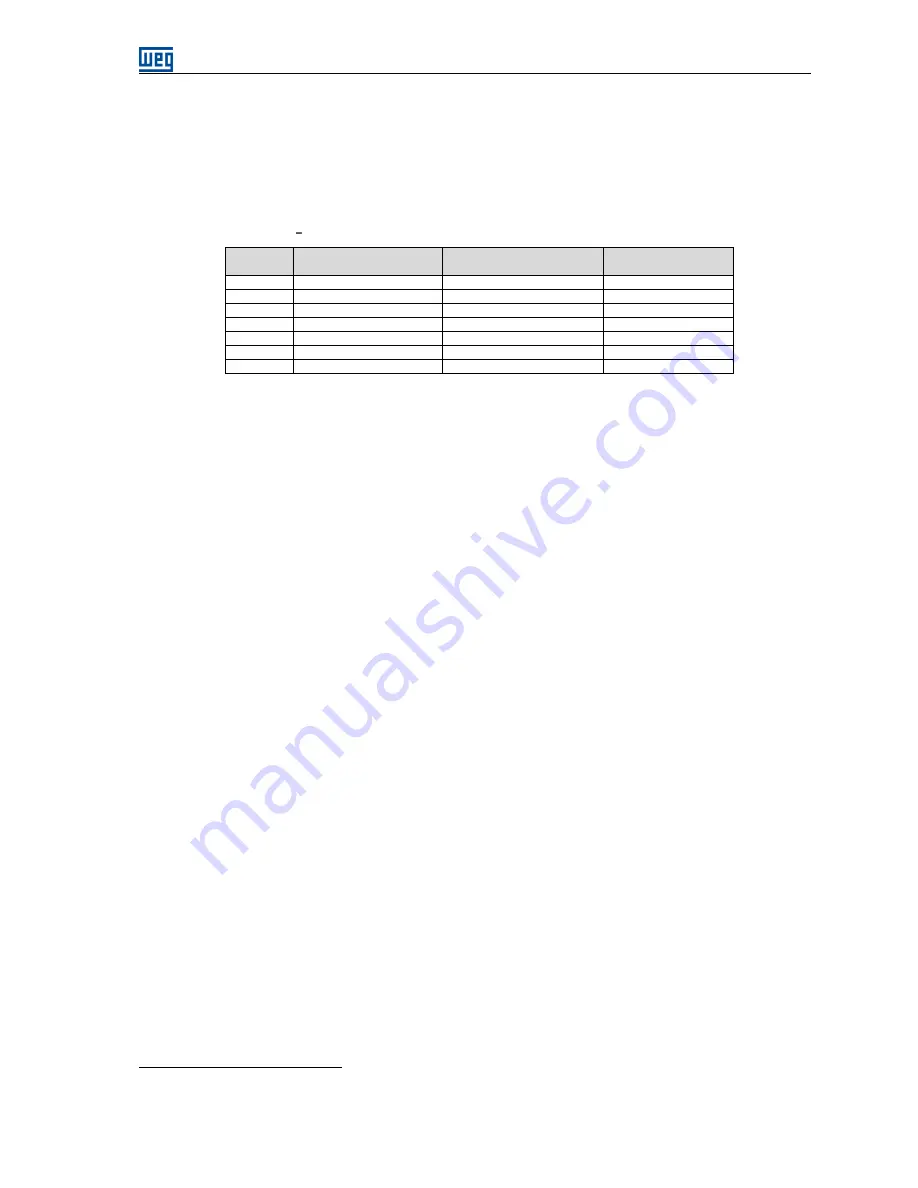
Functional Description
.
ECW500 | 41
6.4
ANALOG OUTPUT
On hardware versions equipped with the electronic board ECWCC1, the ECW500 offers an analog output with
14 bits of resolution which can be configured as voltage (0 to +10 V) or current (4 to 20 mA) through parameter
31060 (Analog Output Signal). The output value, in voltage or current, represents a specific variable of the
system calculated in percentage, with 100% indicating that the value has reached the full scale of the variable.
To select the variable represented on the analog output set parameter 31062 according to the table below.
Table 6.2 Variable represented and full scale for each configuration of the analog output
Option in
31062
Variable Represented
Parameter of the Displayed
Variable
Full Scale
(10 V or 20 mA)
0
Duty Cycle
40062
100%
1
Terminal Voltage
40006
1.2 x 30058
2
Terminal Current
40008
1.1 x 30060
3
Power Factor
40012
(special)
4
4
Active Power
40020
30068
5
Excitation Current
40030
1.2 x 30066
6
Reactive Power
40022
30068
You can apply a gain to adjust the variable through the parameter 31058 (0 to 99.99).
6.5
OPERATION MODES
The ECW500 has five operating modes plus the Off state. They are described below.
6.5.1
OFF
In this mode, the regulator executes all the signal measurements, but it does not apply voltage to the excitation
output terminals. It is possible to shut down the regulator from all modes presented below. However, from this
mode it is only possible to go to the MTVC and MECC.
6.5.2
MTVC (Automatic)
(Mode: Terminal Voltage Control) In the MTVC mode, the ECW500 controls the excitation so as to ensure that
the voltage at the terminals of the synchronous machines follows the voltage reference. In this mode, the
machine operates out of the network (offline), acting in an isolated way. It is possible to go from the MTVC mode
to all other operating modes.
6.5.3
MECC (Manual)
(Mode: Excitation current Control) In the MECC mode, the ECW500 controls the excitation current of the
synchronous machines regardless the terminal voltage of the machine. In this mode, the machine operates out
of the network (offline), acting an isolated way.
The MECC mode has a function to enable the internal reference follower (parameter 30246). This function
enables the transition of other modes to the MECC in a smooth way because the value of the excitation current
is copied as reference for the MECC mode.
In this mode it is also possible to operate with external feedback for the excitation current, giving the ECW500
the ability to control machines with nominal excitation above 20A. To use this feature, set parameter 31028
(External Power Module) to 1 (enabled) and choose which of the analog inputs will be used as feedback: the one
in voltage (31054 = 1) or the one in current (31056 = 1). The control signal for driving an external source will be
sent through the analog output (terminals 11 and 12) by setting parameter 31062 (Analog Output Function) to 0
(Duty Cycle).
Another setting required to operate with external feedback is the value of Full Scale for Excitation Current
(parameter 30256), which is used to calculate the excitation current from the read value at the analog input. The
calculation of the excitation current on this configuration is shown below, in which the first equation is used for
the input in voltage and the second one for the input in current.
4
The representation of the power factor through the analog output is made in a special way. A lagging power factor will be represented by a
value between 0 and the half of the scale (0 V to 5 V or 4 mA to 12 mA). On the other hand, a leading power fator will be represented by a
value between the half and the end of the scale (5 V to 10 V or 12 mA to 20 mA).
Summary of Contents for ECW500
Page 2: ......
Page 8: ......
Page 69: ...Modbus RTU Communication ECW500 61 Figure 7 1 Converter USB RS485 ...






























